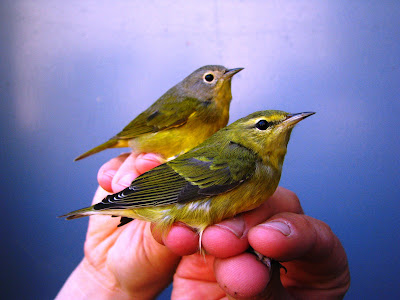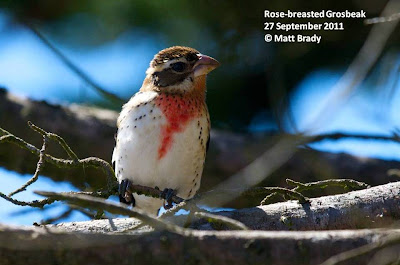Yesterday's Total: 139
Migrant bird: 5 points
Shark sightings: 2 points
Cetaceans: 1 point
2011 Farallon Grand Total points: 147
The final day of Farallonathon was a busy one. It was media day on the Farallones as we were visited by a group of reporters from a variety of local and national media outlets. Between the boat landings and all the media commotion, we didn't have a lot of time to look for migrants, but we still managed to come up with a few. The highlight was a pair of black-throated warblers, one gray and one blue, which dropped in on the island for a brief rest. In addition, a small group of Northern Pintail was observed flying past the island in the morning and two species of migrant gull (Herring Gull and Black-legged Kittiwake) were also seen flying by.
There were no shark attacks observed today, guess they weren't hungry. But there were two sharks seen at the surface to give us two points. Finally, one Blue Whale was spotted cruising past the island in the morning. The massive spout of this majestic species is unmistakable and brought us our final point for this year's Farallonathon.
Even though the Farallonathon is officially done, you can still donate to help support the Farallones. To support our research, you can donate a flat amount or you can make a pledge based on the Farallonathon point system. To donate a flat amount online, simply go to the Farallonathon team webpage, and click on the DONATE button. Now that you know the total number of points achieved you can easily calculate your per point donate and submit that amount online Or, if you prefer not to use the online method, please email Jim Tietz (jtietz@prbo.org) for details on how to submit your pledge.
(All photos copyright Dan Maxwell)
 |
| Biologist Pete Warzybok being interviewed by the crew from KGO-TV channel 7 while Mark dilligently searches for migrants. See the story here. |
 |
| Black-throated Blue Warbler in it's native habitat - granite outcrops on remote islands. |
 |
| Cedar Waxwing flying over the house in the early morning. |
Farallonathon - Bonus Days!
The Farallonathon runs for seven straight days and we rack up as many points as we can during this time period to help raise funds for Farallon research. So, day 7 was the last official day and we got a grand total of 147 points. This is the fourth lowest total ever for a Farallonathon. Weather conditions just didn't cooperate to bring in the birds this season and two days in particular were very poor weather days with dense fog, rain and no birds.This is the luck of the draw and the difference between a couple of nice days and a couple of poor days can be quite dramatic for Farallonathon. For example if we had dropped the two rainy, foggy days from the Farallonathon where we weren't able to see the ocean and where migrant birds were unable to find the island and replaced them with the next couple of days at the end (Days 8 and 9) we would have had a total of 174 points this year.
Here are a few of the highlights from those bonus days:
Day 8: 24 points! Three shark attacks, 1 new butterfly (Common Buckeye), 1 new dragonfly (Black Saddlebags) and 7 new migrant birds (Red-shafted Flicker, Red-breasted Nuthatch, European Starling, Tennessee Warbler, Nashville Warbler, Pine Siskin and Dickcissel).
 |
| Dickcissel spotted on Lighthouse Hill |
 |
| Nashville, Tennessee - a tribute to the Volunteer State |
Unfortunately we don't have any good photos of these species since the ducks and swifts were just flying by and the Longspur was in and out of the grasses being generally photo resistant.
However, this just goes to show you how much luck and weather factor into the Farallonathon. Tune in again next fall to see how we do. Maybe we will get good weather for all 7 days next year and break the record! And please, donate if you are able. You may donate a flat amount or a per point amount for either the official total (147) or the bonus total (174) or any amount you choose. Every dollar raised helps to support research and conservation on the Farallon Islands.


















































